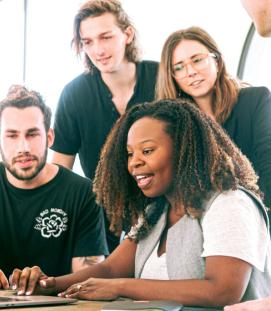Communities, tools and accessibility – CDPS’s Head of User Centred Design, Jo Goodwin, sets out the 3 priorities for user-centred design as she takes up her new role
During my first few weeks with CDPS, I’ve been sharing ideas with a lot of people inside and outside of the organisation. This shared thinking has challenged initial ideas and helped to refine the three priorities for user-centred design in the next few months.
The CDPS advisory panel, colleagues in local government and health, our internal teams at CDPS and many others have provided challenges and feedback to create the following priorities, a special thank you to everyone who has helped to shape them!
Priorities
1. People, communities and networks
The first priority for user-centred design is about people. There are many networks and communities already established across Wales, in both the public sector space and wider, including CDPS’s own communities of practice. We need the right support and network of people working across Wales to embed user-centred design across Welsh products and services.

There are many people working in the user-centred design space that work in isolation. A lone user researcher, a solo content designer, a service designer working with subject matter experts, or a team with a single designer. We see you, and it is a tough role. You’re not alone and we’ll be working to bring people together (everyone, not just the ones who work as individuals) to share, scale and support each other. Through communities, we also hope to share best practice and wherever we can, remove duplication (how many of us are trying to do the same things in our organisations?).
Following a review of what is already happening, we will build a model for community engagement ensuring there is room for practitioners but also those with interest in learning about user-centred design. We will also be looking to bring together communities of action for short-term, outcome-oriented communities to come together and solve shared problems.
The ambition for communities is to break silos and to own and share best practice, skills, and learning.
2. Tools and frameworks
Like a decorator with a paintbrush, user-centred design practitioners need the right tools to do the job.
Over the next few months, we will be looking at that toolkit and filling it with all the things to enable user-centred design within CDPS and wider.
The ambition is to take the best from across Wales, share that and use it. Many of the items we are considering are already in operation in some organisations – we are looking to share and scale, so please get in touch if you have things to share!
We haven’t confirmed what is in and out yet – we have some ideas, but it will be a question about what practitioners need. Stuff we are exploring include ResearchOps tools such as participant recruitment, consent forms, research incentives, and research libraries. We will be working with the CDPS communities of practice to explore guides and tools.
If you have stuff to share, please get in touch. And if you would like to be involved, the approach we want to take to building this, is through collaboration across the public sector, so let’s do this together! Also, if you don’t have time to get involved, but a particular tool, guide or process would help you in your role, let us know.
3. Making user-centred design accessible to all services across Wales
There are a lot of public servants, officers and people working across Wales who want to make their products and services as good as they can be. This priority is about making user-centred design open and accessible to those people.

There are lots of myths about making services user-focused. Some of the ones I have heard in Wales include:
“I am afraid to ask people what they think of my service, I know it is far from perfect”.
Some of the challenges to applying user-centred design I hear quite often is the time and capability people face.
“There just aren’t enough hours in the day to get the job done”.
Another myth is that user-centred design only applies to projects or programmes and that services that operate in ‘business as usual’ mode don’t need to think about it.
This work will find ways to reach officers and public service teams that are on the never-ending treadmill of delivering services, to implement small ways to check-in with their users and find small tweaks or iterative changes to their services to make them a little better, in small steps.
The ambition for this priority is to embed small changes and often, across all services in Wales to make a big impact over time.
Challenges
The three priority areas for user-centred design are ambitious. There are lots of challenges and barriers to overcome if these are to be successful.
We know there are silos in all areas of the public sector in Wales. We need to find ways to break down some of these silos.
We also know there is fear in adopting new ways of working. Things have been tried before and they haven’t worked. It is far more comfortable to accept the areas we know are not working as we hope, than to risk anything by trying new things.
We know there is very little money or time in Welsh public services. Everyone is stretched, busy and struggling to maintain service delivery (user-centred design can help with both time and money!).
We also know there is a skills gap in digital skills and user-centred design as a discipline and practice is in its infancy in many areas of Wales.
We know we are on a journey. But it is an exciting journey – more of an adventure, really. It is exciting and I am looking forward to what we achieve.
If you have feedback, ideas or want to get involved, we would love to hear from you!
Tweet us, email us, or come along to one of our communities of practice.